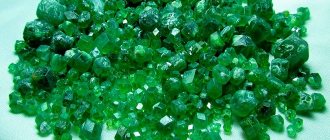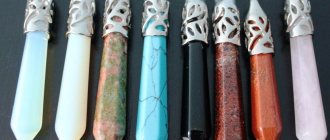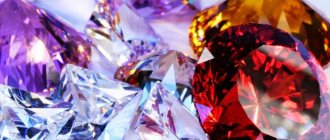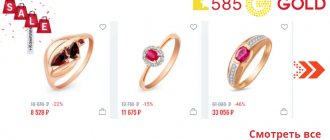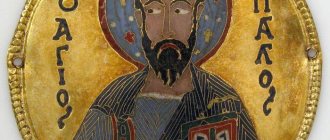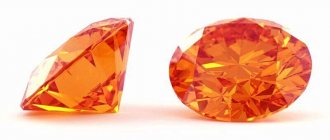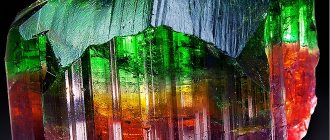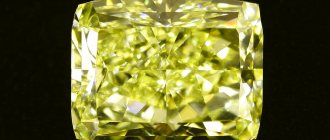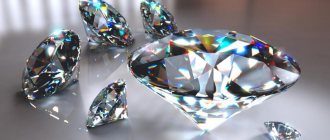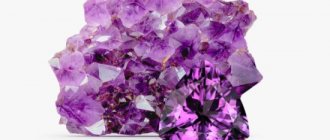History and origin
It is believed that the first gems were discovered in Southeast Asia. People were delighted with the strength of the mineral and associated many legends with it. They called it corundum.
Sapphire
Versions about the origin of the name “sapphire”:
- from the ancient Greek σάπφειρος - “blue stone”;
- from the Babylonian “sipru” - “scratching”;
- from Sanskrit – “favorite piece of heaven.”
In Ancient Rus' it was called azure yakhont, and all blue minerals were then called “bausy”. According to Indian legend, blue corundum is amrita, the elixir of immortality. The creator petrified the liquid so that people would not use it. The importance of blue sapphire as a symbol of power is indisputable. A rich natural (without refining) gem is an attribute of the first pontiffs and rulers, for which it is called royal.
King Solomon owned the sapphire seal. Style icon Lady Di loved jewelry with gems. Her daughter-in-law Kate Middleton received an engagement ring with a pink stone that Diana once received from Prince Charles.
Today, for a jeweler, sapphires are all corundums, except red (which is a ruby). For a mineralogist, sapphire is only blue corundum.
Where did sapphire come from or dive into history
From the moment of its discovery, this precious stone began to conquer humanity with its durable characteristics and unprecedented beauty. It was first found on the Asian continent, in the east and southern part. Another name for sapphire is corundum. A little later, other minerals with similar features and origin came under this name.
There is a myth in India that sapphire can bring immortality to a person. If we rely on a legend from ancient times, the creator of the mineral created it in such a way that it became a fossil and did not fall into the hands of ordinary people.
Sapphire is rightfully considered the mineral of rulers and kings, since it was they who loved it very much, considering the mineral a symbol of limitless power.
As everyone knows that Solomon's seal is made from this precious stone.
The historical roots of sapphire are also curious. Scientists believe that the gem received its name from different nationalities. An interesting fact is that the Romans classified sapphire as lapis lazuli. The ancient Slavs called all such precious stones baus.
It is interesting that the name of sapphire has quite an ambiguous connotation among experts. Scientists include only bluish corundum among them. But in jewelry, this is a large layer of varieties of corundum of the most beautiful colors (only red is not included). The famous rubies are called red gems.
Princess Diana adored sapphires; for her wedding, her future husband gave her jewelry with this particular stone. Currently, it has been inherited by her daughter-in-law; a photo of the royal couple’s sapphire stone can be easily found on the Internet.
Physicochemical characteristics
Sapphire is a variety of corundum and is the top tier of the four most expensive gemstones. It is surpassed in hardness only by diamond.
Heat treatment discolors the crystals; exposure to x-rays increases the density of the sapphire color.
| Formula | Al2O3 |
| Color | Blue and cyan in various shades; colorless, pink, orange, yellow, green, purple, black |
| Shine | Glass |
| Transparency | Transparent to opaque |
| Hardness | 9 |
| Cleavage | Absent |
| Kink | Rough to conchoidal |
| Density | 3.95 - 4.00 g/cm³ |
Simple recommendations
● Indicate the main parameters and shape of the drawing element. Draw the outlines of the stones. Use different shapes and sizes of objects in your sketch to convey the realism of the image.
● Mark the dark and light areas. Add additional lines to indicate light and dark areas on the stones. If the light should fall from the right from above, therefore, the marks on the stones must be placed along the top on the right side. The darkest parts of the stones are on the lower left side.
● Apply shadows and shading. Use continuous vertical strokes to make the surface of the stones appear smooth. To create shading and volume of the stones, it is necessary to enhance the color of the left side.
Place of extraction
Several countries conduct industrial mining of the mineral. Top class cornflower blue specimens are mined by hand in Kashmir at an altitude of 4000 m for four months of the year when the mountains are free of snow. Australia produces 80 percent of all stones, but they are inexpensive, in price terms only a quarter of the world market.
Sapphire
Padparadscha, rare pink and blue “Ceylon” gems, come from the island of the same name. Thailand, Myanmar (Burma), Vietnam and Cambodia are rich in greenish “Siamese” minerals. Multi-colored specimens are found in Africa (Tanzania, Kenya) and the USA. In Russia, non-jewelry raw materials are mined in the Urals and Khibiny Mountains.
Sapphire deposits
Sapphires are not uncommon in nature. The mineral is mined in Africa, Madagascar, Burma, Thailand, India, Vietnam, Australia, Brazil, Tanzania, and also in the USA. The only exception is Antarctica.
Did you know that...
The oldest deposit is on the island of Ceylon, where sapphire is revered as the national stone.
It is the sapphire deposit that determines its value: the most expensive and rare blue specimens were brought from Kashmir (the mines were closed in the 1930s). They have an extraordinary color - pure blue with a light milky-violet haze, which appears due to the presence of tiny cavities filled with liquid in the stone.
Today, the largest producers of colored sapphires are Sri Lanka and Madagascar.
Varieties and colors
Sapphires have a wide range. A blue crystal is considered a classic. The remaining shades are “fantasy”.
Colors
There are yellow, orange, green, colorless, pink, black specimens. In this case, the description of the stone includes an indication of color.
- Blue. A classic but rare sapphire color. More often it is a mineral with bluish, grayish tints. A specimen containing up to 15% of other shades is considered blue. If it is more, the stone is classified as fancy with a double name (for example, yellowish blue). Color is created by titanium and iron: the more, the thicker the shade. However, an excess of deep blue depreciates the value of the gem. The most valuable is the velvety cornflower blue Kashmir sapphire of moderate intensity.
Blue sapphire
- Yellow. A rare variety, yellow sapphire is slightly cheaper than blue. Nickel creates a range of shades from yellowish to amber or orange. Lightly colored specimens are considered transparent.
Yellow sapphire
- Black. Half or fully opaque lustrous stone. It's actually blue, but the saturation creates the illusion of black.
Black sapphire
- Blue. Expensive valuable gem. Blue sapphire almost always comes from India. Specimens from Sri Lanka are distinguished by their milkiness and resemble moonstone.
Blue sapphire
- White (leucosapphire). Color is created due to the absence of impurities. Leucosapphire imitates a diamond, reducing the cost of jewelry without sacrificing aesthetics and quality. Natural white sapphire is rare and is often the result of heating colored light sapphires.
White sapphire
- Green. In fact, green sapphire lacks this color. Under a microscope, it is noticeable that the greenery forms an interweaving of yellow and blue segments. The colors come from cobalt and magnesium.
Green sapphire
- Pink. The tint is created by manganese. The delicate color does not obscure the shimmer in the sun. Due to its affordable (compared to diamonds) price, pink sapphire is more popular than a similar diamond. Americans and Japanese especially love jewelry with this corundum. Little known in Russia.
Pink sapphire
- Padparadscha. The pink-orange crystals are called padparadscha, the shade of a lotus flower. They are not present in the available assortment; the significance of this stone is especially understood in the East.
Padparadscha
- Violet. The purple color is created by vanadium. Known as "oriental amethyst". Mined in Australia, rare.
Purple sapphire - Grey. It is of value only with the asterism effect.
Gray sapphire
Varieties
Connoisseurs appreciate types of multi-colored sapphires, united by some kind of “zest”.
- Star-shaped. Star sapphire is so named due to its unique effect - asterism. A beam directed at the crystal reveals a star on the surface: 6- or 12-rayed (double asterism). Rays are created by rutile. The star mineral is processed as a cabochon: this is how the effect is manifested to the maximum. The best specimens are mined in Thailand, the rarest and most valuable are green. The clarity of the star shape increases the price, while blurriness (when there is little rutile) reduces it.
- "Cat's eye" Named because of the stripe that runs across the stone and makes it look like a cat's eye. Parallel needle inclusions create rutile and other minerals. Processed cabochon.
- Alexandrite. Alexandrite sapphire is a stone that changes color under different lighting: green in daylight and reddish-violet (purple) in artificial light.
- Songea, Tunduru. Particularly pure varieties of sapphire with a rich palette. Often with an asterism effect. Named after deposits in Tanzania. Rarely larger than 1.5–2 carats, but so perfect that they fetch from $2,000 per carat of processed stone.
- Declassed. Declassed sapphire - stones of any color, but of low quality: opaque, dark, contaminated with inclusions.
Red corundums are called rubies.
2. Sapphire is one of the four most expensive stones in the world.
3. Sapphire was considered a symbol of power, fidelity, chastity and modesty.
4. The term “sapphire” goes back to the Babylonian “sipra”, which means “scratching”. This name could be due to the extraordinary strength of the mineral. Ancient Greek also has a similar word, which is written as "sappheiros".
5.Today, cornflower blue sapphires (Kashmiri, Burmese, Ceylon types) are considered the most valuable.
6. Sapphires of high quality and extraordinary beauty are mined in Sri Lanka, Madagascar, India, Thailand, Burma, Australia and Brazil.
7. Indian gems, which are characterized by velvety texture and a color similar to cornflower (Kashmir deposit), are usually valued more than others. This variety is considered the most valuable and expensive, but the reserves of this deposit, unfortunately, have been greatly reduced recently.
8. Scientists indicate that in Greece this was the name for any blue mineral.
9. In Kievan Rus, sapphires were known for a long time as “azure yachts”.
10. For a long time, sapphires were understood as all stones colored in shades of blue, for example, lapis lazuli. And only in the 18th century, the chemist G. Vallerius from Sweden made a proposal to call only transparent blue corundums sapphires.
11. Sapphire is a precious variety of corundum. Chemically, it is aluminum oxide.
12. It can be painted in a variety of colors: shades of blue, light blue, pink, yellow, green, red-orange, purple.
13. Pure aluminum oxide is colorless, and the color of sapphires is due to the presence of inclusions, including titanium, chromium, manganese, iron, vanadium.
14. Sapphire crystals have a glassy luster, trigonal structure and conchoidal fracture. They have no cleavage, and they are very strong and hard, they can be either transparent or opaque,
15. Sapphire is almost as hard as diamond. Only a diamond can scratch the surface of a sapphire. The stone occupies the second line of the Mohs scale, corresponding to nine units out of ten possible.
STAR SAPPHIRE
16. One of the expensive jewelry varieties of sapphire is the opaque star sapphire, in which, when processed as a cabochon, a 6- or 12-rayed star appears, which, when turning the sample, seems to slide along its surface. This property is called asterism and is associated either with the presence of rutile in the mineral in the form of thin needles that intersect each other at angles of 120°, or with hollow tubular tubules that pass through the stone.
17. This is how A.E. writes about sapphire. Fersman: “dense blue with a velvety tint, Kashmiri, bright blue, sparkling with a dazzling own fire, Siamese, bright cornflower blue with a purple tint, Ceylon, very dark, almost black in artificial light, Australian.”
18. Contrary to popular belief, sapphires can be not only blue. The color of the gem can be yellow, pink, green, orange and purple. Sapphires of these unconventional colors are called “fancy.”
19. As for the colored varieties for sapphire, there are such as padparadscha, songea or tundura.
20.Padparadscha is a sapphire colored orange-pink. The name of the mineral goes back to the Senegalese “ladma rajaya”, which translates as “lotus color”. The gem was first discovered in Ceylon, where its color was described as a cross between pink lotus and Ceylon sunset orange. Pure yellow or pure orange crystals do not belong to this type.
21.Padparadscha rarely weighs more than 2 carats, but the New York History Museum has such a rare gem as a specimen weighing 100.18 carats.
22.Songea and tunduru sapphires are named after their deposits located in Tanzania. These subspecies are unique and very diverse in color palette. The average weight of samples is 1.5-2 carats.
23.Sapphires that are pink, green, yellow, or two-colored are also rare. Such stones are usually very small, but due to their rarity they are highly valued.
24.But blue sapphires have remained the most popular and famous for many centuries in a row. They decorated the crowns of rulers in Great Britain, Russia, and the Netherlands.
25. The dark blue St Edward's sapphire is in the center of the cross of the British Empire Crown.
PINK SAPPHIRE
26. According to ancient Hebrew concepts, sapphire is a symbol of justice: the seal of the wise and fair King Solomon was supposedly made of sapphire, and his throne was decorated with a fabulous star sapphire.
27. In the Middle Ages, sapphire was called the “bishop’s stone,” believing that it personified the highest spiritual values.
28. Busts of three American presidents were carved from sapphires: Washington (1997 carats), Lincoln (2302 carats), Eisenhower (2097 carats).
29. According to descriptions, Alexander the Great wore a sapphire ring.
30. It is known for certain that Queen Mary Stuart also wore a similar ring.
31. A brooch with a huge Ceylon sapphire in a sparkling halo of diamonds is kept in the Diamond Fund of Russia. This sapphire is one of the seven historical stones of the Diamond Fund. It was purchased by Russian Tsar Alexander II for his beloved wife at an exhibition in London. In addition to its amazing color, the stone also attracts with its stunning processing. It has more than 100 facets, and the diamond setting was chosen with extreme taste.
32. Thanks to its marvelous heavenly color, sapphire was already considered sacred in Ancient Greece and Ancient Rome and was dedicated to the father of all gods - Zeus.
33.Only priests can wear a sapphire in a ring on their index finger; the stone helps them hear and understand what the oracle says.
34.According to the book of the great Exodus, the god Yahweh gave Moses the Ten Commandments, engraved on sapphire tablets (large stones).
35. In the Middle Ages, sapphire was revered as a symbol of holiness, infallibility and inviolability of power; kings abundantly decorated their crowns and other regalia with it.
36. Boris Godunov, a great lover of gems, considered sapphire the most beautiful and powerful talisman
37. Sapphire is expensive and small. Most often, stones weighing up to two carats are found. Sapphires ranging in size from two to five carats are rarely mined.
38.Stones weighing over five carats are truly precious - also due to their rarity. Therefore, a large blue sapphire of high jewelry quality is difficult to buy even for those who are not strapped for money.
39. A 62-carat sapphire adorned John Rockefeller’s ring.
40. Sapphire is one of the 12 stones that adorned the Heavenly Jerusalem, according to the description given in the Apocalypse. This gem has become a symbol of salvation and reconciliation between God and people.
41. Sapphires from Australia and Kenya have a green tint and are less valuable.
42. In ancient times, sapphires were used in the treatment of eye diseases. They were believed to help with leprosy and other skin diseases and have antidote properties. Indian Ayurveda recommends sapphire for neuralgia, epilepsy, hysteria, and sciatica.
43.Modern lithotherapy uses sapphires for insomnia, back pain, colds, bronchial asthma, heart disease and oncology. The mineral has a good effect on the body in case of diabetes, kidney disease and hypertension.
44. Sapphire is the patron of such zodiac signs as Aquarius and Sagittarius. It is not recommended to use or wear jewelry with gems only for Capricorns. Representatives of other signs can use sapphire, but its properties will not be as powerful for them.
45. Exposure of colorless or lightly colored sapphire to a high-temperature environment leads to an intensification of the blue color of the crystal. As a rule, all blue sapphires that reach the jewelry counter are preheated. This is normal, generally accepted practice.
46. In addition to heating, other methods of refining sapphire are used. Diffuse impregnation of sapphire with titanium changes the structure of the crystal lattice to a depth of one atom - but this is enough to form a blue layer. Beryllium can be used instead of titanium.
47.Cracks in stone can be filled with lead glass. All stones processed in this way should cost several times less than their natural counterparts.
48. A 1-carat cut blue sapphire is valued at $100 to $300, depending on the quality and origin. Treated colored rare specimens such as Padparadscha, Songea or Thunduru cost $2,000 or more per carat.
49.Unpainted or colorless sapphires are called leucosapphires. Their small crystals often form scatterings on jewelry, emphasizing the beauty of large and bright satellites. The shine of small leucosapphires is difficult to distinguish from the brilliant shine.
50. The rich and famous have always loved items with sapphires, be it a brooch, necklace, choker, bracelet, earrings or ring.
51.Probably the most famous piece of sapphire jewelry today is Princess Diana’s engagement ring, which Britain’s Prince William gave to his fiancée Kate Middleton.
52. All jewelry with sapphires are highly durable; they do not lose their properties under external influences.
53. To clean jewelry, use warm soapy water and a soft brush, after which they are rinsed with cool running water and polished with a soft cloth.
54 Sapphire is a valuable and expensive jewelry stone. Since its discovery, it has always been used by man in jewelry due to its high hardness and durability.
55. Not only is it convenient for jewelers to work with sapphire, but it is also simple and undemanding to care for and retains its visual appeal for many years.
photo from open sources
Artificial sapphire
Transparent and colored corundums are actively synthesized.
The first was created in 1904 by Auguste Verneuil. The method is based on droplet deposition in an oxygen-hydrogen flame.
Later, the Czochralski method and its modifications were developed - the crystal is drawn from the melt of the seed. Samples weighing up to 300 kg are obtained. They are cut to the required size and polished.
Artificial sapphires
World production is hundreds of tons annually. Main suppliers: Russia, China, USA, Japan. One of the largest enterprises in this field operates in Russia.
Gemstone - a simple drawing technique
Are you interested in the specifics of how to draw a gemstone and at the same time preserve the resemblance to the original as much as possible?
In reality, depicting an “expensive” stone is not difficult. This can be done in just a few steps. To work, you only need a pencil, ruler, eraser and paper.
Step 1. Draw two different geometric shapes. Draw an inverted regular triangle below, and draw a trapezoid on top of it.
Medicinal properties
The healing properties of the mineral have been studied for centuries. Lithotherapists have found that the gem treats heart disease, asthma, skin diseases, kidney diseases, and women's ailments. Helps with diabetes, migraines, removes stones from the body. Improves mental state.
Sapphire is a stone of longevity. Maintains clarity of mind, inhibits senile ailments such as sclerosis or marasmus.
If possible, use certain colors of natural stone:
- yellow - debugging the body’s functioning, increasing immunity, relieving depression and stress;
- blue - treatment of headaches, dermatological problems, inflammation, heart disease, blood vessels;
- green - improved sleep (the stone is placed under the pillow), vision;
- white - maintaining peace of mind.
Yellow sapphire is energetically strong and can be worn periodically. With constant use, the stone provokes anxiety and restlessness.
Sapphire water is healing: the pebble is infused in it from sunrise. Wash wounds, sore areas of the body, eyes.
Healing properties. Who is sapphire suitable for as a magic stone?
Over a long period of history, healers have been engaged in research and discovery of new medicinal qualities of the gem. They found that sapphire can be used to cure various diseases. It is usually recommended for use in diseases of the heart, respiratory system, skin, diabetes, gynecology, mental disorders, etc. According to experts, sapphire will help get rid of a large number of diseases, but the color of the gem plays a big role in getting rid of ailments.
Both men and women can use it as a magical talisman.
Magic properties
The gem connects the earthly world with the heavenly.
Multi-colored sapphires
Stones bring out the best in a person, just like light sapphires are suitable as a children's amulet.
Are common
Sapphire is a symbol of altruism, friendship, sacrifice. For a woman it becomes a talisman of chastity. The magic of the gem preserves love and family ties.
The owner of the stone is always in a good mood, it is difficult to deceive him. Makes men calmer, but more decisive. Helps you become a leader, lead wisely, listen to people. Rulers wore it around their neck or crown as protection from envy and their own mistakes.
The sapphire wedding is celebrated on the 45th anniversary of marriage. In silver, the healing effect of the stone is enhanced; sapphire in gold makes the owner decisive and helps to become a leader in life.
Color Specialization
The magical properties of colored stones are different:
- white helps to achieve the goal; a good gift for a loved one, an attribute of adherents of spiritual practices;
- yellow will attract inspiration to creative people, enhance the abilities of practicing magicians, and protect against anxiety;
- star-shaped retains the properties of a talisman when the owner changes; he will become an intuitive, recognize lies;
- green is an attribute of everyone who wants but cannot remember dreams; makes egoists sensitive altruists; useful in a house where people like to quarrel;
- blue is the stone of rulers, aesthetes and philosophers; improves the thinking process; makes you tune in to work or take a break; activates superpowers, opens the “third eye”; makes the timid into bold “truth tellers”, the mediocre even more worthless;
- blue attracts luck, love, helps to learn new things; banishes doubts; helps travelers;
- pink attracts in life what the owner thinks about; if you give it to the bride, she will never change;
- black is the most powerful of amulets and talismans; a magnet of wealth, a ring is an attribute of serious people: it streamlines the thought process, prevents spontaneity of decisions and actions; eliminates depression by restoring self-confidence.
The magical properties of any sapphire only help in matters with a plus sign.
Otherwise, the pebble will remain indifferent or pass on the negative to the owner.
Properties
It has the basic properties of corundum.
Physico-chemical
Fluorescence:
- blue sapphire - absent;
- colorless sapphire - violet, orange-yellow.
| Pleochroism, crystal color | Effect color |
| Blue | deep blue, greenish blue |
| Yellow | yellow-green, yellow |
| Violet | light red, purple |
The blue color of the stone comes from admixtures of iron and titanium, while the violet color comes from vanadium.
Lithotherapists advise
Sapphire is the “stone of nuns.” It was believed that the gem would help maintain chastity. He will willingly help his kind, pure-hearted owners.
Traditional healers claim that the stone:
- Helps with hypertension.
- Relieves back pain.
- Relieves colds.
- Helps get rid of “all sorts of evil growths”
For asthma, heart disease, neuralgia, wear a sapphire bracelet or ring on your left hand.
Different colors, different magic
All sapphires bring a positive outlook to their owners.
Expert opinion
Semenishcheva Polina
Specialist in mineralogy. Graduated from St. Petersburg Mining University.
Note : esotericists consider star sapphire the most powerful magical variety of corundum.
Previously sorcerers and magicians, and now esotericists
